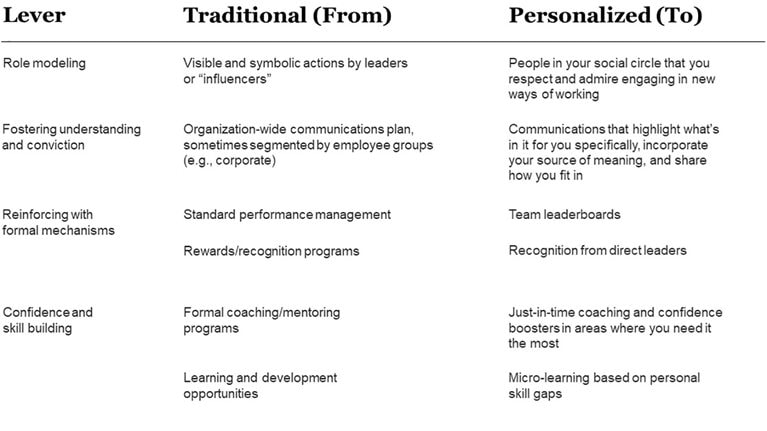Successfully transforming an organization continues to be one of the greatest challenges facing leaders, as it requires changing the behaviors and underlying mindsets of a critical mass of people. Behavioral-science research shows that there are four levers to driving change: role modeling, fostering understanding and conviction, reinforcing with formal mechanisms, and building confidence and skills. Together, these are known as the influence model. A change-management plan that uses all four levers increases the likelihood of success threefold.
However, we live in an increasingly personalized world where people expect information to be curated just for them. This creates an opportunity to move away from a one-size-fits-all approach to change. Personalizing tried-and-true strategies like the influence model empowers people to engage in the change in ways that are personally meaningful. That, in turn, improves the odds of making change stick.
A personalized influence model
While the levers of a personalized influence model remain the same, the tactics within each become contextualized to suit individual needs (see Exhibit).
Exhibit

Consider a company that wants to boost accountability by more clearly linking individual performance and consequences. The support that people receive would vary based on the exact behaviors they’re focusing on and the underlying mindsets that stand in their way of doing things differently.
For example, Marissa is a plant manager who needs to focus on giving differentiated feedback but fears hurting relationships with coworkers. Here’s how each lever can be personalized for her:
- Role modeling: See other plant managers give differentiated feedback to their teams.
- Fostering understanding and conviction: Learn how targeted feedback can strengthen relationships and hear from colleagues the value of receiving differentiated feedback.
- Reinforcing with formal mechanisms: Get encouragement from other managers and track feedback conversations on a personal progress board.
- Confidence and skill building: Receive bite-sized tips on giving strengths-based feedback and digital “nudges” linked to her calendar to encourage feedback.
Meanwhile, Lisa is a finance individual contributor who needs to proactively seek feedback. Her limiting mindset is a feeling that she doesn’t have enough time.
- Role modeling: See peers make time to ask for feedback.
- Fostering understanding and conviction: Learn why it’s worth making time to ask for feedback (e.g., save time in the long run, career benefits).
- Reinforcing with formal mechanisms: Get recognized for seeking feedback and include in personal development plan.
- Confidence and skill building: Receive tactics to embed feedback into daily routine and learn how peers make time to ask for feedback.
Take the following steps to create your own personalized influence model.
- Determine meaningful employee segments, such as job level or role.
- Break down organizational goals into specific behaviors that demonstrate what “great” looks like for each group.
- Use focus groups or analytics to uncover people’s preferences and underlying mindsets.
- Develop and roll out personalized actions across each lever, using tech-enabled tools to enable mass deployment.
- Track progress and iterate in real time to maximize impact.
Taking a one-size-fits-all approach to change management is a thing of the past. By personalizing tried-and-true strategies, leaders can drive lasting change at scale.
